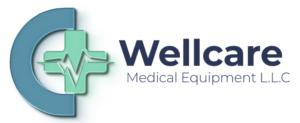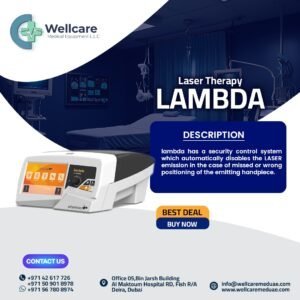Medical Equipment Supplier in United Arab Emirates
Well Care Medical Equipment LLC is a prominent supplier of medical equipment in the United Arab Emirates (UAE), dedicated to enhancing healthcare services across all emirates: Abu Dhabi, Dubai, Sharjah, Ajman, Umm Al-Quwain, Fujairah, and Ras Al Khaimah. Their comprehensive approach ensures that healthcare providers, from hospitals to clinics, have access to the latest medical technology and equipment necessary for delivering high-quality patient care.
The key factors driving the need for medical equipment in all the emirates of the UAE are deeply connected to the country’s ambitious healthcare goals, demographic changes, and the evolving needs of both residents and expatriates.
1. Population Growth and Urbanization
The UAE has experienced rapid population growth, fueled by a combination of high birth rates and a large influx of expatriates. This demographic shift has resulted in an increased demand for healthcare services across all emirates. Urbanization has also led to the development of new residential and industrial areas, requiring more hospitals, clinics, and healthcare centers. Each facility needs a wide range of medical equipment—from basic diagnostic tools to advanced medical technology— to meet the needs of a growing, diverse population.
2. Healthcare Expansion Initiatives
The UAE government, under its Vision 2021 and Vision 2030 initiatives, is heavily investing in expanding healthcare infrastructure to provide world-class healthcare access across all regions. This commitment to building new healthcare facilities and upgrading existing ones drives the demand for medical equipment, from hospital beds and surgical instruments to high-tech diagnostic imaging systems (e.g., MRI, CT scanners) and patient monitoring systems. The goal is to ensure equitable healthcare services across both urban and rural areas of the country.
3. Rising Prevalence of Chronic Diseases
Chronic diseases such as diabetes, hypertension, cardiovascular conditions, and obesity are on the rise across the UAE, creating a heightened need for long-term care and disease management. These conditions require specialized medical equipment for monitoring and treatment, including blood glucose meters, dialysis machines, ECG monitors, and cardiac devices. As lifestyle-related diseases become more common, the demand for equipment that can help manage these conditions increases across all emirates.
4. Medical Tourism
The UAE, especially in Dubai and Abu Dhabi, has positioned itself as a top destination for medical tourism. However, other emirates like Sharjah and Ras Al Khaimah are also entering the medical tourism market, creating an increased need for cutting-edge medical technology. Tourists seek specialized treatments such as cosmetic surgery, fertility treatments, orthopedic care, and cardiac surgery, all of which require state-of-the-art medical equipment to meet international standards of care. This demand extends beyond the larger cities and is driving healthcare investment across the country.
5. Aging Population
As life expectancy increases, the UAE’s population is aging, leading to a growing need for medical care related to age-related conditions. This includes an increasing number of elderly patients who require chronic disease management, rehabilitation, and palliative care. Medical equipment such as mobility aids, home care devices, diagnostic equipment, and rehabilitation tools are in greater demand to cater to the elderly population. Hospitals and nursing homes in all emirates must be equipped with the necessary devices to handle this demographic shift.
6. Technology-Driven Healthcare
The UAE is keen on adopting advanced healthcare technologies to ensure that its medical services are on par with global standards. Digital health technologies, telemedicine, robotic surgery, and AI-powered diagnostic tools are becoming integral to modern healthcare systems. Hospitals and healthcare providers in every emirate need access to high-tech equipment such as telemedicine platforms, remote patient monitoring systems, and advanced imaging devices to provide faster, more accurate, and efficient healthcare services.
7. Focus on Emergency and Critical Care
The UAE places a strong emphasis on improving emergency and critical care services. All emirates need to be equipped with modern emergency medical equipment, including ventilators, defibrillators, ICU monitoring systems, and life-support devices. This ensures quick response to accidents, trauma cases, and other critical situations, improving the overall outcomes for patients. Emergency departments and ambulances across the country must be fully equipped to handle any crisis effectively.
8. Regulatory Compliance and International Standards
The UAE has strict healthcare regulations, with a focus on adhering to international standards of medical care. To maintain these standards, healthcare providers in all emirates must continually upgrade their medical equipment and ensure that their devices meet the required safety and efficiency criteria. This push for compliance with global standards drives the demand for new and upgraded medical equipment.
9. Pandemic Preparedness and Infection Control
The COVID-19 pandemic has heightened awareness about the importance of preparedness for future health crises. The need for personal protective equipment (PPE), ventilators, ICU beds, and advanced diagnostic tools surged during the pandemic. The UAE is now focused on enhancing its readiness for any future public health emergencies by investing in additional medical equipment across all healthcare facilities in the emirates. Laboratories, hospitals, and clinics are enhancing their capacity for infectious disease control, further driving the demand for specialized equipment.
10. Healthcare Workforce Growth
With the expansion of healthcare facilities, there is a parallel increase in the healthcare workforce. Doctors, nurses, and technicians require specialized training and access to modern medical tools to deliver quality care. The demand for training simulators, laboratory equipment, and other teaching aids is rising as medical schools and training centers in the UAE grow. As healthcare professionals increase, so does the demand for up-to-date medical technology that supports their work.
11. Preventive Care and Wellness
The UAE government is placing a greater focus on preventive healthcare and wellness to reduce the burden of chronic diseases and improve public health. Initiatives promoting early diagnosis, health screening, and regular check-ups require various medical devices such as diagnostic equipment, imaging tools, and laboratory testing machines. Every emirate is increasing its investment in preventive healthcare, which requires extensive equipment for effective implementation.
In summary, the need for medical equipment in all emirates of the UAE is driven by population growth, the rise of chronic diseases, healthcare expansion initiatives, medical tourism, and the increasing adoption of advanced medical technologies. The UAE’s commitment to providing world-class healthcare, along with its focus on emergency preparedness and compliance with international standards, means that all emirates need continuous upgrades and investment in a wide range of medical devices. These factors ensure that each region is equipped to meet the healthcare needs of both residents and visitors.
Well Care Medical Equipment LLC plays a crucial role in supplying medical equipment across all emirates in the United Arab Emirates (UAE). Here are some key points highlighting their contributions and services in the region:
1. Wide Coverage Across Emirates
- UAE Presence: Well Care Medical Equipment LLC is dedicated to serving healthcare facilities in all emirates, including Abu Dhabi, Dubai, Sharjah, Ajman, Umm Al-Quwain, Fujairah, and Ras Al Khaimah.
- Accessibility: Their extensive network ensures that medical equipment is accessible to hospitals, clinics, and healthcare providers, regardless of location.
2. Diverse Product Offering
- Comprehensive Equipment Range: The company supplies a variety of medical devices, including:
- Diagnostic equipment (ultrasound machines, X-ray machines)
- Surgical instruments and tools
- Patient monitoring systems (heart rate monitors, blood pressure monitors)
- Rehabilitation equipment (physiotherapy tools)
- Emergency medical equipment (defibrillators, ambulatory equipment)
- Specialized Medical Solutions: Well Care provides specialized equipment for various fields, such as gynecology, ENT, pediatrics, and general surgery, catering to the specific needs of different healthcare sectors.
3. Quality and Compliance
- High Standards: Well Care is committed to delivering products that meet international quality standards and regulatory compliance, ensuring patient safety and effective healthcare delivery.
- Collaboration with Renowned Brands: The company partners with reputable manufacturers, allowing them to offer cutting-edge technology and reliable medical equipment.
4. Customer Support and Services
- After-Sales Support: Well Care provides ongoing support, including maintenance, training, and technical assistance, ensuring healthcare providers can use the equipment effectively.
- Tailored Solutions: The company understands that each healthcare facility has unique requirements and offers customized solutions to meet specific needs.
5. Training and Education
- Professional Development: Well Care organizes training sessions and workshops for healthcare professionals to enhance their skills in using medical equipment safely and effectively.
- Product Demonstrations: They often conduct demonstrations to showcase new equipment, helping healthcare providers understand its features and benefits.
6. Focus on Innovation
- State-of-the-Art Technologies: The company continuously seeks to integrate the latest advancements in medical technology into their product offerings.
- Adaptation to Market Needs: Well Care stays updated with industry trends and emerging healthcare challenges, allowing them to provide relevant solutions.
7. Contribution to Healthcare Accessibility
- Affordable Solutions: Well Care aims to make medical equipment more accessible and affordable for healthcare facilities across the UAE, particularly in underserved areas.
- Partnerships: They may collaborate with government entities and NGOs to enhance healthcare delivery, ensuring a broader reach of medical services.
Well Care Medical Equipment LLC is dedicated to improving healthcare across all emirates in the UAE by providing a wide range of high-quality medical equipment and exceptional customer support. Their commitment to quality, innovation, and accessibility makes them a vital partner for healthcare providers, contributing significantly to the enhancement of medical services in the region.
What types of medical equipment does Well Care Medical Equipment supply in the UAE?
Well Care Medical Equipment supplies a wide range of products including hospital beds, diagnostic machines, surgical instruments, patient monitoring systems, emergency equipment, and home healthcare devices.




